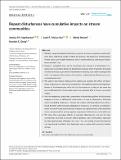Files in this item
Repeat disturbances have cumulative impacts on stream communities
Item metadata
| dc.contributor.author | Haghkerdar, Jessica M. | |
| dc.contributor.author | McLachlan, Jack R. | |
| dc.contributor.author | Ireland, Alexis | |
| dc.contributor.author | Greig, Hamish S. | |
| dc.date.accessioned | 2019-02-15T12:30:05Z | |
| dc.date.available | 2019-02-15T12:30:05Z | |
| dc.date.issued | 2019-02-14 | |
| dc.identifier | 257750063 | |
| dc.identifier | 77ad9d51-e285-4c05-b3c6-d632d0975cb8 | |
| dc.identifier | 85062676562 | |
| dc.identifier | 000460668800043 | |
| dc.identifier.citation | Haghkerdar , J M , McLachlan , J R , Ireland , A & Greig , H S 2019 , ' Repeat disturbances have cumulative impacts on stream communities ' , Ecology and Evolution , vol. Early View . https://doi.org/10.1002/ece3.4968 | en |
| dc.identifier.issn | 2045-7758 | |
| dc.identifier.other | RIS: urn:48BC90A8FAB6D2A5DB5A5712F8E8AB30 | |
| dc.identifier.uri | https://hdl.handle.net/10023/17076 | |
| dc.description | This project was supported by the USDA National Institute of Food and Agriculture, Hatch (or McIntire‐Stennis, Animal Health, etc.) project number #ME0‐21607 through the Maine Agricultural & Forest Experiment Station. Maine Agricultural and Forest Experiment Station Publication Number 3653. | en |
| dc.description.abstract | 1. Climate change has altered disturbance regimes in many ecosystems, and predictions show that these trends are likely to continue. The frequency of disturbance events plays a particularly important role in communities by selecting for disturbance-tolerant taxa. 2. However, ecologists have yet to disentangle the influence of disturbance frequency per se and time since last disturbance, because more frequently disturbed systems have also usually been disturbed more recently. Our understanding of the effects of repeated disturbances is therefore confounded by differences in successional processes. 3. We used in-situ stream mesocosms to isolate and examine the effect of disturbance frequency on community composition. We applied substrate moving disturbances at five frequencies, with the last disturbance occurring on the same day across all treatments. Communities were then sampled after a recovery period of 9 days. 4. Macroinvertebrate community composition reflected the gradient of disturbance frequency driven by differential vulnerability of taxa to disturbance. Diversity metrics, including family-level richness, decreased, reflecting a likely loss of functional diversity with increasing disturbance frequency. In contrast, overall abundance was unaffected by disturbance frequency as rapid recovery of the dominant taxon compensated for strong negative responses of disturbance-vulnerable taxa. 5. We show that cumulative effects of repeated disturbances?not just the time communities have had to recover before sampling?alter communities, especially by disproportionately affecting rare taxa. Thus, the timing of past disturbances can have knock-on effects that determine how a system will respond to further change. | |
| dc.format.extent | 9 | |
| dc.format.extent | 747673 | |
| dc.language.iso | eng | |
| dc.relation.ispartof | Ecology and Evolution | en |
| dc.subject | Community composition | en |
| dc.subject | Diversity | en |
| dc.subject | Dominance | en |
| dc.subject | Resilience | en |
| dc.subject | Vulnerability | en |
| dc.subject | QH301 Biology | en |
| dc.subject | DAS | en |
| dc.subject | SDG 13 - Climate Action | en |
| dc.subject.lcc | QH301 | en |
| dc.title | Repeat disturbances have cumulative impacts on stream communities | en |
| dc.type | Journal article | en |
| dc.contributor.institution | University of St Andrews. School of Biology | en |
| dc.identifier.doi | https://doi.org/10.1002/ece3.4968 | |
| dc.description.status | Peer reviewed | en |
This item appears in the following Collection(s)
Items in the St Andrews Research Repository are protected by copyright, with all rights reserved, unless otherwise indicated.

